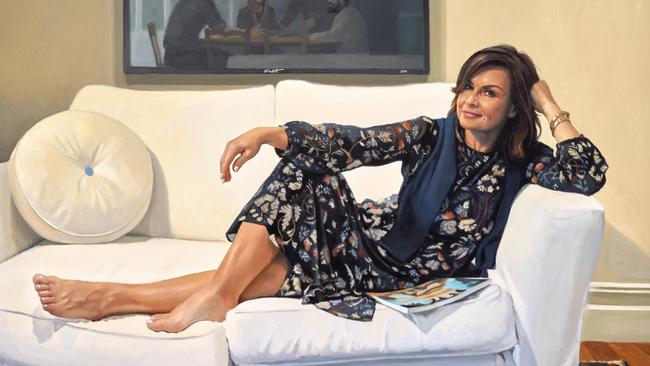Archibald Prize 2017: it pays to paint from life and avoid blow-ups
The best Archibald entries are neither oversized nor based on photographs.

Spending most of your time talking and occasionally slapping a palette knife loaded with a sludge of different colours on to the canvas is not usually the way to a sensitive likeness.
Although it’s not nearly as overdone, I’m not sure why Robert Malherbe chose to paint his self-portrait on the scale he did. He is a talented artist and the work could have been much more engaging on a human scale.
Also a very able painter, and someone who has often worked on quite a small scale, Marcus Wills has made an otherwise striking full-length portrait of Thomas Wright simply too big to engage the viewer in the way implied by its title: Protagonist, antagonist.
One large picture that has a plausible raison d’etre is the portrait of my friend John Vallance, because it is a collective and valedictory production by the boys of Sydney Grammar’s Edgecliff Preparatory School.
For the same reason, it is understandable that the work is based on a photograph.
In other cases, there is no such excuse: Dee Smart’s The mayor of Bondi is obviously copied from a snap. So is Kimberley Leutwyler’s Michelle Heyman — and a glance at the artist’s website shows that this is a typical, although toned-down, version of her standard formula: a photographic portrait against a random background of decorator splashes. Wouldn’t you get bored repeating the same soulless recipe again and again?
Less conspicuously, the portrait of Robert Forster from the Go-Betweens by an artist who gives his name as “what” is also derived from the shadows of a photo, or even a photocopy of a photo. And Sophia Hewson’s all-singing, all-dancing Sound of Music portrait of Richard Bell is really, when all the kitsch and other paraphernalia are discounted, just a snap of its subject’s grinning face.
Julius Killerby appears to be technically talented but his portrait of Paul Little has a rather lifeless quality that betrays the reliance on photographic sources — as one can confirm from the pictures posted on his Instagram page.
A later post suggests he may be beginning to trust himself to work more from life. Other pictures, like the double portrait of James Drinkwater and Lottie Consalvo, appear to be done with a hybrid process — no doubt some sittings for the faces, which are quite lively, but photographic references for the hair and other details that feel flat.
Peter Smeeth’s portrait of Lisa Wilkinson, with her family reflected in the background — the Packing Room winner this year — is also ultimately a painting of a photo-shoot, in which the artist has not been able to differentiate between what matters — the character of the sitter — and what does not.
Philip Meatchem’s adjacent portrait of Francis Greenslade, in contrast, has managed to keep the upholstery of the sofa in its place.
Seated gentlemen of a certain age dominate a solid group of pictures predominantly if not entirely done from life by some of our most prominent portraitists.
One of the best of these is Nicholas Harding’s fine portrait of John Olsen, one of the doyens of Australian painting today.
The choice of an upright and frontal pose, directly facing the viewer, acknowledges Olsen’s now considerable age but emphasises too his quiet strength and determination.
Also impressive is Robert Hannaford’s Michael Chaney, one of the most respected figures in Australia’s corporate world, here identified modestly as a geologist.
Hannaford’s portraits appear highly realistic and are remarkable likenesses, but his use of a surprisingly limited palette — visible on close inspection — and his underlying architecture of light and shade endow the pictures with an unexpected kind of artifice.
Chaney sits upright with relaxed poise, while Lucy Culliton’s Steve Peters, the outgoing head of the packing room staff and the man responsible over the years for the famous Packing Room Prize, sinks back into an armchair.
Particularly poignant is Jun Chen’s portrait of Ray Hughes, the formerly irrepressible art dealer, now sadly confined to a wheelchair.
Hughes is seen in the opening of two curtains, as though to evoke the narrowing world of his life in age and illness; but although the idea is a touching one, the perfunctorily painted curtains detract from the final effect of the picture.
Also impressive is Noel Thurgate’s Homage to Peter Powditch, in which a sympathetic and accurate portrait of the sitter is set in unexpected relief against a remarkable textured background of wood and cardboard inlays. And in a very different vein, Mitch Cairns turns Agatha Gothe-Snape into a sort of neo-Matisse pattern of colour shapes.
Among the most interesting and appealing pictures, as always, are several smaller ones, including Natasha Walsh’s self-portrait (she has done a lot of other work from photos but this must be painted in the mirror).
Jordan Richardson’s little picture of John Bell, a study in absorption, is remarkably engaging, drawing us into the sitter’s concentration even though we cannot see his eyes.
Jessica Ashton’s Self-portrait as a clown is also an example of the freshness and vitality that come from painting from life: she addresses the viewer with almost the same intimacy as inspecting her own features in the mirror. The clown costume adds a note of pathos but also, from a painterly point of view, reflects a warm red glow into the shadow side of the face — another effect that speaks of working from life.
Finally, one of the most striking pictures in the exhibition is Andrew Bonneau’s portrait of the sculptor Ayako Saito, which I happened to watch being painted when I dropped into the artist’s studio on a couple of occasions. The second time, a mutual friend exclaimed that it seemed almost more like the sitter than she was herself.





To join the conversation, please log in. Don't have an account? Register
Join the conversation, you are commenting as Logout